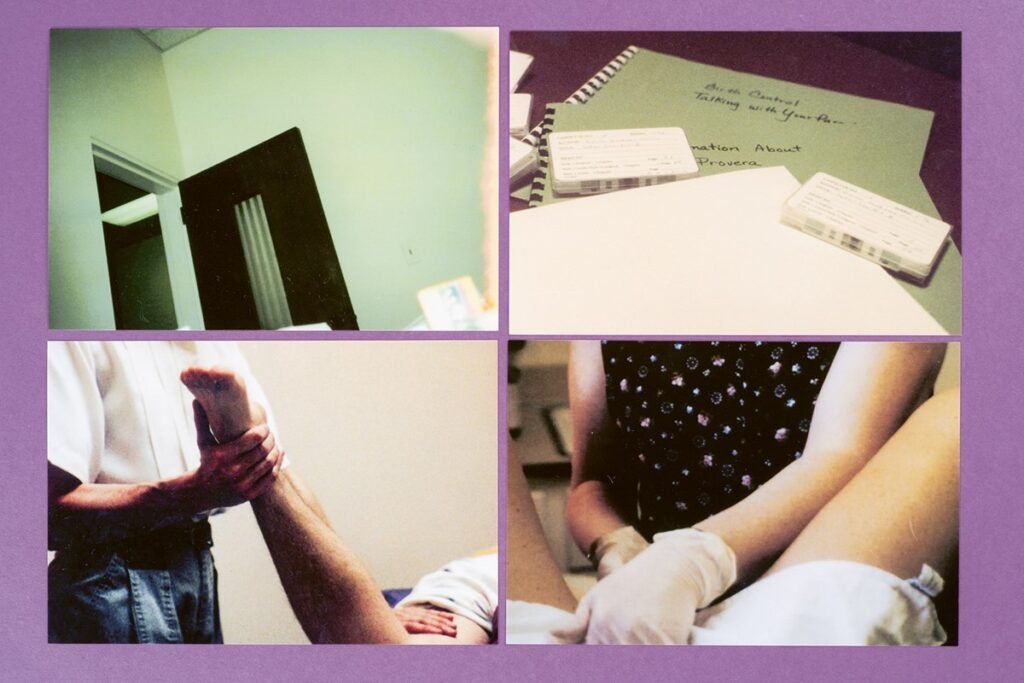What does abortion look like, and who has come to define it? These are two questions that guided the Columbus-based visual artist and writer Carmen Winant as she worked on her newly published photobook, The Last Safe Abortion. To Winant, it was blatantly clear that abortion imagery, even for those of us who are steadfast in the belief that women should have bodily autonomy and access to abortion, is defined by what anti-abortion groups have presented to us. “I’ve long thought about how anti-abortion agitators effectively weaponise images as a political tool to stigmatise what is simply an extension of healthcare,” Winant tells Dazed over Zoom. “On the contrary, we pro-choice feminists have been slow to utilise pictures as a strategy in our movement building and larger advocacy. This project is trying to fill that void.”
Initially conceived as an exhibit for the Minneapolis Institute of Art and now published by SPBH Editions and MACK as a book curated from personal and institutional archives across the American Midwest that span the period between 1973 and 2022 (when access to abortion was a constitutional right), the photographs in The Last Safe Abortion are not sensational – at least not in the way the word is typically used. Instead, as the viewer flicks through the spiral-bound photobook, they will repeatedly encounter seemingly “regular images” of abortion workers at their desks, scheduling appointments, hosting workshops on reproductive healthcare or in examination rooms changing bedding and drawing blood. Focusing on these aspects, on the mundane and the quotidian, was imperative to Winant, who wants the visual vocabulary of abortion to move past the archaic images of coat hangers or gory foetuses. “There’s this inclination to lace any representation of abortion, positive or negative, with trauma and conflict,” she says. “I wanted to countermand that notion of abortion care and represent it solely as healthcare. I wanted to capture the work of the work.”
“I’ve long thought about how anti-abortion agitators effectively weaponise images as a political tool to stigmatise what is simply an extension of healthcare” – Carmen Winant
These unsensational acts of feminist healthcare are central to Winant’s artistic practice, surfacing in an earlier series from 2018 titled My Birth, which, in a similar manner, offered up a demystified visual vocabulary of labour and childbirth. “I initially wanted to make something graphic and evocative, but what interested me more than images of babies crowning was the healthcare workers in the backgrounds pressing on a pelvis, offering support or weighing the baby. I wanted to capture these moments that demonstrate tenderness and care,” Winant shares.
In The Last Safe Abortion, these moments of care can be glimpsed in the numerous photographs of abortion workers and their latex-clad hands. In some images, these hands are carefully holding onto a speculum during a pelvic exam. In others, they wrap around the patient’s wrists and backs as a marker of support. Care is perhaps most significant and just as invisible in the numerous photographs of abortion providers answering the phone. It was an image that the artist frequently came across in archives across the Midwest. “These photographs of healthcare workers answering the phone run deep in every archive,” Winant explains, reminding me how crucial these hotlines were 60 years ago when access to life-changing abortion services was facilitated by the healthcare worker on the other end of the line.
It was also an image that she repeatedly captured when she was photographing clinics for the project. “It’s so obvious to point out, but the phones are always ringing off the hook. Particularly now as more clinics are shuttering, and the ones that are still operating have ten times the amount of patients coming in. These abortion workers are switching between languages, advising people, and always answering the phones. It’s the least photographic act,” Winant admits. “But picking up the phone came to represent for me, in terms of sociality, coalition building and most importantly, demonstrating care, the most essential, life-saving act.”
“There’s this inclination to lace any representation of abortion, positive or negative, with trauma and conflict. I wanted to countermand that notion of abortion care and represent it solely as healthcare. I wanted to capture the work of the work” – Carmen Winant
As suggested by the title, Winant’s book is underscored by the reversal of Roe v Wade in June 2022, following which access to abortion was banned or at risk in 26 states across the United States. For the artist and many pro-choice feminist activists, this decision signalled a terrifying turn for abortion rights. It became more and more urgent for Winant to look critically at the chasm between her own political organising and artistic practice. Working closely with abortion clinics, she carefully went through hundreds of boxes of archival material, conducted interviews and carefully picked out the photographs for the project. They were then arranged alongside her own photography.
Interlacing the archive with contemporary imagery “serves a double purpose” by acknowledging how the struggles of the 1960s and 1970s in America is embedded actively in our struggles in accessing abortion care now, Winant explains. Addressing those who ask why she works with the past, she says: “In The Last Safe Abortion, I do not think I am engaging in a sentimental or nostalgic process when I work with the archive but rather, understand myself as participating in an ongoing, active and a live trajectory of resistance work and feminist movement building.”
The Last Safe Abortion by Carmen Winant is published by SPBH Editions and MACK and is available here.






